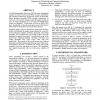Free Online Productivity Tools
i2Speak
i2Symbol
i2OCR
iTex2Img
iWeb2Print
iWeb2Shot
i2Type
iPdf2Split
iPdf2Merge
i2Bopomofo
i2Arabic
i2Style
i2Image
i2PDF
iLatex2Rtf
Sci2ools
ICCAD
2003
IEEE
2003
IEEE
On the Interaction Between Power-Aware FPGA CAD Algorithms
As Field-Programmable Gate Array (FPGA) power consumption continues to increase, lower power FPGA circuitry, architectures, and Computer-Aided Design (CAD) tools need to be developed. Before designing low-power FPGA circuitry, architectures, or CAD tools, we must first determine where the biggest savings (in terms of energy dissipation) are to be made and whether these savings are cumulative. In this paper, we focus on FPGA CAD tools. Specifically, we describe a new power-aware CAD flow for FPGAs that was developed to answer the above questions. Estimating energy using very detailed post-route power and delay models, we determine the energy savings obtained by our poweraware technology mapping, clustering, placement, and routing algorithms and investigate how the savings behave when the algorithms are applied concurrently. The individual savings of the power-aware technology-mapping, clustering, placement, and routing algorithms were 7.6%, 12.6%, 3.0%, and 2.6% respectively. The major...
| Added | 16 Mar 2010 |
| Updated | 16 Mar 2010 |
| Type | Conference |
| Year | 2003 |
| Where | ICCAD |
| Authors | Julien Lamoureux, Steven J. E. Wilton |
Comments (0)

